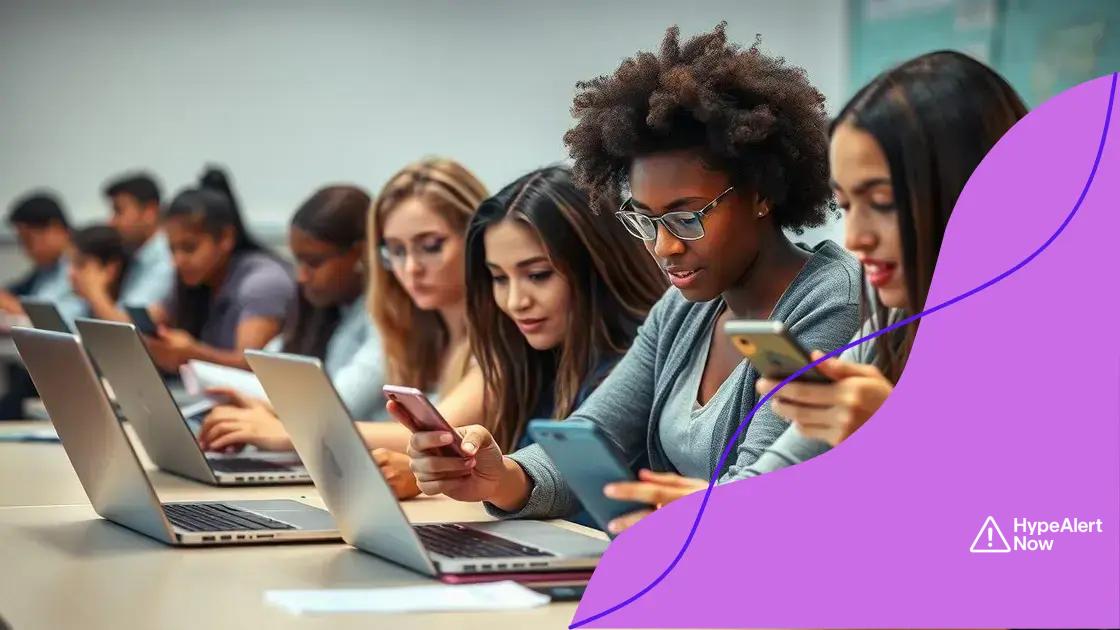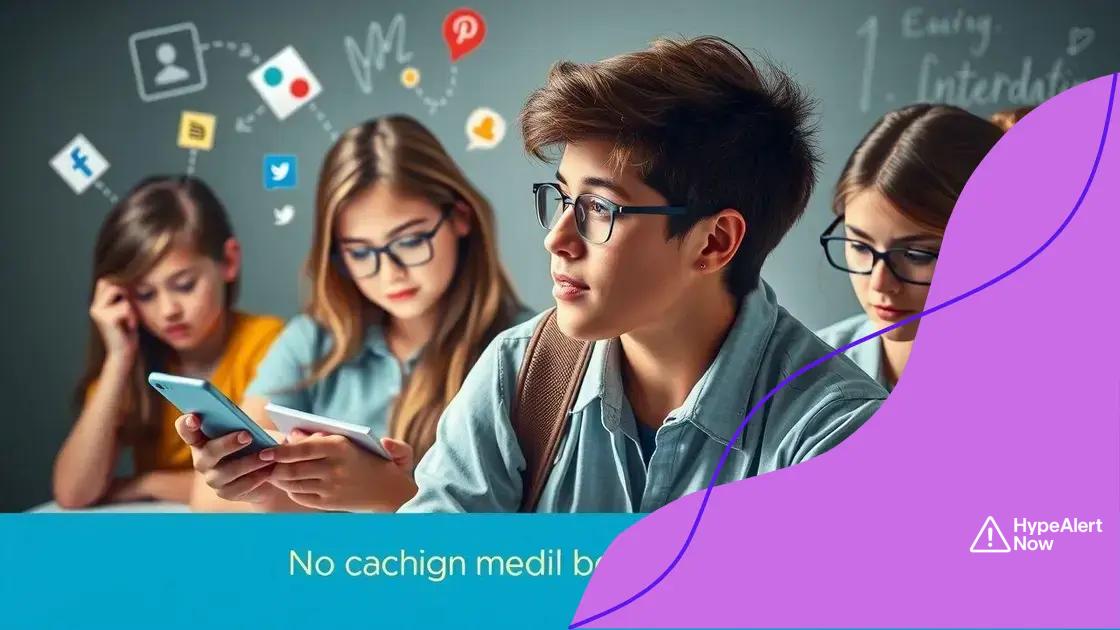Impact of social media on student learning: What to know

The impact of social media on student learning includes enhanced engagement through collaboration and communication, while also presenting challenges like distractions and cyberbullying, necessitating mindful usage and effective strategies for balance.
Impact of social media on student learning has become a significant topic among educators and parents. Have you noticed how platforms like Instagram and TikTok fit into students’ daily routines? Let’s dive into this conversation.
The role of social media in education
Social media plays a crucial role in education today. Platforms like Facebook, Twitter, and LinkedIn are not just for socializing; they also serve as valuable resources for students and teachers alike. Understanding how social media influences learning can enhance educational experiences.
Connecting Students and Educators
One major benefit of social media is the ability for students and educators to connect outside traditional classrooms. Students can ask questions, share resources, and collaborate on projects. This communication often leads to deeper understanding.
Enhancing Learning Opportunities
Social media facilitates access to a wide range of information. It enables students to:
- Follow experts and thought leaders in various fields.
- Participate in online discussions relevant to their studies.
- Access educational videos and resources shared by peers and educators.
These tools provide enriching experiences, making learning more engaging and interactive. However, there are challenges to navigate, such as maintaining focus and minimizing distractions. For example, students often find it hard to concentrate due to the constant notifications from their social media accounts.
A New Learning Environment
Social media creates new learning environments that extend beyond classroom walls. It’s essential for educators to embrace these tools to enhance the learning process. Through the use of collaborative platforms, students develop vital skills like teamwork and communication.
With proper guidelines, the positive effects of social media can outweigh the negatives. Educators can create structured activities around social media tools. This ensures students use them effectively and responsibly, reinforcing their learning while managing their screen time. Ultimately, integrating social media into education can be a transformative experience for students.
Benefits of social media for student engagement
The benefits of social media for student engagement are numerous and impactful. By utilizing platforms students already frequent, educators can foster a more interactive and inclusive learning environment. Social media provides a dynamic way to encourage participation and collaboration among students.
Increased Participation
One major advantage is that social media encourages more students to participate. In a traditional classroom, some students may hesitate to share ideas or ask questions. However, on social media, students can express themselves more freely, leading to richer discussions. This platform lowers barriers for those who might feel shy or intimidated.
Real-Time Feedback
Another benefit is the ability to provide real-time feedback. Through social media, teachers can:
- Quickly address students’ questions.
- Share important announcements.
- Provide instant feedback on assignments or projects.
This immediate interaction creates a sense of community and keeps students engaged in their learning process. Moreover, it helps in building relationships between educators and students, making them feel valued and supported.
Collaborative Learning
Social media promotes collaborative learning among peers. Students can work together on group projects, share resources, and support one another. For instance, platforms like Google Classroom allow for collaborative editing and ongoing discussions. Engaging with classmates outside of the classroom extends learning beyond regular hours.
This enhanced interaction often leads to deeper understanding of the material. By engaging in discussions and sharing different perspectives, students can clarify concepts and learn from each other.
Furthermore, integrating social media into educational practices encourages students to develop essential skills for the digital world. They learn how to communicate effectively, manage their online presence, and use digital tools responsibly. By embracing social media, educators are preparing students for a future where these skills are critical.
Challenges posed by social media in learning

While social media offers numerous benefits for education, there are also significant challenges posed by social media in learning. Understanding these challenges helps educators and students navigate the complexities of online interactions and use these platforms more effectively.
Distraction and Decreased Focus
One of the biggest challenges is distraction. Students often find it hard to concentrate on their studies when they are surrounded by notifications and updates. The constant buzz of social media can lead to:
- Increased procrastination.
- Frequent interruptions during study time.
- Difficulty completing assignments on time.
These distractions can affect academic performance, making it essential to establish clear boundaries for social media use during school hours.
Cyberbullying and Negative Interactions
Another serious issue is the rise of cyberbullying. Social media can become a platform for negative interactions. Students may experience:
- Harassment from peers.
- Exclusion from social groups.
- Emotional distress that impacts their academic life.
These situations can lead to anxiety, depression, and decreased school performance. It is crucial for schools to address these situations and provide support for affected students.
Inaccurate Information
Moreover, the abundance of information available on social media can be misleading. Students might encounter inaccurate or biased content, which can confuse their understanding of important subjects. This highlights the need for critical thinking skills, as students must learn to evaluate sources and discern factual information from opinion.
As educators incorporate social media into learning, they should teach students how to recognize trustworthy information and develop their analytical skills. This awareness is vital for navigating online spaces responsibly. Encouraging homework that requires research on social media can be beneficial, allowing students to practice these skills actively.
In summary, while social media can enrich the educational experience, recognizing and addressing these challenges is essential. By understanding the potential pitfalls, students and educators can work together to create a more positive environment for learning.
Strategies to balance social media use
Finding effective strategies to balance social media use is vital for students. While social media can enhance learning, excessive use can lead to distractions and negative outcomes. With the right approach, students can enjoy the benefits while minimizing the drawbacks.
Establishing Clear Boundaries
One of the first steps is to set clear boundaries on social media use. Students should determine specific times for checking social media, such as:
- During breaks from studying.
- After completing homework or projects.
- In the evenings, allowing for relaxation before bed.
This approach ensures that social media does not interfere with important tasks and helps maintain focus on academics.
Utilizing Time Management Techniques
Incorporating time management techniques can also help students balance their social media habits. For example, using a planner can assist students in organizing their schedules effectively. This allows them to:
- Allocate specific time slots for studying.
- Plan out social media activities as rewards.
- Track time spent on social media to promote awareness.
By setting limits on social media, students can enjoy their online interactions without compromising their schoolwork.
Promoting Mindful Social Media Use
Mindfulness is another critical strategy. Students can practice being more aware of their social media habits. This involves:
- Reflecting on how social media affects their mood and focus.
- Identifying which activities provide value and which are purely distracting.
- Choosing to engage with positive and educational content.
By being mindful, students can reduce negative feelings associated with social media use and create a more fulfilling online experience.
Finally, it’s essential to encourage open discussions about social media in educational settings. Educators can lead conversations about responsible use, highlighting both the benefits and challenges. By creating a supportive environment, students feel more comfortable sharing their experiences and seeking help when needed. Ultimately, striking a balance between social media and academic responsibilities prepares students for a more successful future.
Future trends in social media and education
The future trends in social media and education are rapidly evolving as technology continues to advance. Staying aware of these trends is essential for educators and students to maximize the benefits of social media in learning environments.
Integration of Virtual Reality
One significant trend is the integration of virtual reality (VR) in education. VR can create immersive learning experiences, allowing students to explore complex concepts in a virtual space. Using social media to share these experiences can enhance engagement.
Personalized Learning Through Data
Another trend is the use of data analytics to personalize learning experiences. Social media platforms can collect data on student engagement and preferences. This information can guide educators in tailoring their teaching methods to meet the specific needs of students. By focusing on individual learning styles, educators can foster a more effective educational environment.
Enhanced Collaboration Tools
Future social media tools will likely emphasize collaboration among students and teachers. Enhanced platforms will provide features that allow for interactive learning and peer-to-peer support. Through these tools, students can work on projects together, sharing insights and resources effectively.
Additionally, educators may utilize new social media platforms designed specifically for educational purposes. These platforms will focus on security and privacy while promoting communication and collaboration. This will create a focused environment where learning can thrive.
Emphasis on Digital Citizenship
As social media grows, teaching students about digital citizenship will become increasingly important. Educators will need to focus on guiding students to navigate online interactions responsibly. Teaching principles of respect, safety, and integrity will be vital in preparing students for the digital world.
Schools will incorporate lessons on how to responsibly use social media, emphasizing the importance of critical thinking and evaluating online content. This understanding will empower students to become informed and responsible digital citizens.
Overall, the future of social media in education holds great promise. By embracing these trends, educators can create an enriching environment that prepares students for success in a digital and interconnected world.
FAQ – Frequently Asked Questions About the Impact of Social Media on Student Learning
How can social media enhance student engagement?
Social media encourages communication and collaboration among students, making learning more interactive and fun.
What challenges do students face with social media?
Students can experience distractions, cyberbullying, and misinformation, which can hinder their learning and well-being.
What strategies can help students balance social media use?
Establishing clear boundaries, using time management techniques, and promoting mindful use are effective strategies.
What trends should we expect in social media and education?
Future trends include the integration of VR, personalized learning through data, and a focus on digital citizenship.
